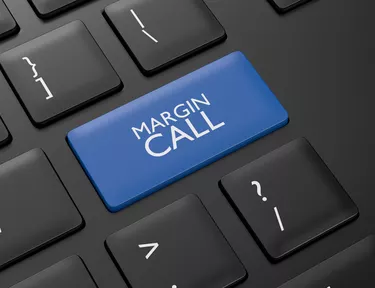
When you get started trading securities like stocks through a brokerage company, such as TD Ameritrade, Fidelity or Robin Hood, you'll usually deposit cash into your account so you can start buying investments with the funds. But if you meet the broker's requirements, you can also opt for a margin account that provides you with more flexibility as an investor. Trading on margin lets you borrow money from your broker so you can trade securities costing more than the cash and equity available in your account. However, this option comes with a lot of risk that you'll need to consider before getting started.
What's Trading on Margin?
Video of the Day
Trading on margin involves borrowing as much as 50 percent of the purchase price from your broker so that you can purchase stock and other securities you otherwise couldn't with your own money. Suppose if you had $4,000 cash in your brokerage account and wanted to buy $8,000 in stock, then your broker could let you take out a $4,000 margin loan, and you could fund the other half with cash. However, margin trading also lets you borrow money against the equity your marginable investments have earned.
Video of the Day
You'll pay interest on the margin loan, and the interest rate usually varies based on market conditions and the loan amount. You'll eventually need to pay your broker back the margin loan amount plus interest. This might involve paying it back as you sell securities or setting up a payment schedule.
You'll usually need to either upgrade a cash account or request a margin account to have access to this option, and your broker will have requirements you have to meet. For example, there's a minimum margin requirement whereby you'll need the lesser of the security's purchase price or $2,000 cash deposited in your account to qualify. Further, you'll need a maintenance margin that must be no less than 25 percent of your margin securities' market value.
Consider also: What Is Margin Debt?
Why Trade on Margin?
Trading on margin appeals to investors since it helps with boosting buying power. For example, if you see a stock that is expected to rise in price shortly, you could use a margin loan to purchase a higher amount than the existing money in your account and possibly boost returns this way. So, if you borrowed $4,000 to purchase $8,000 in stock and the stock rose in value by 25 percent, you would be able to keep extra profits even though you need to pay back the borrowed money plus interest.
You can also use a margin loan to diversity your portfolio since you may not have to turn to selling existing securities to buy new ones. Further, trading on margin can come in handy when selling short so you can profit on stock declines.
Consider also: How to Buy and Sell Stocks on Etrade
Why Is Margin Trading Risky?
While margin trading could help you boost returns when you buy profitable securities, you can also end up in financial trouble if your securities decline. For example, what if the $8,000 in stock you bought on margin fell in value to $4,000. You'd have taken out a $4,000 margin loan and would now need to make up the difference, plus you still have to pay interest. In severe cases of falling investment values, you can lose all the money you deposited plus end up with a shortage where you need to add funds to compensate.
Another risk you face with margin trading is the possibility of a margin call that happens if you don't meet the maintenance requirements and relates to how securities' values fluctuate. This call may occur with or without your broker contacting you with a deadline to fix the issue. The broker could end up selling your securities – since they're collateral for the margin loan – and put you on the hook for any shortage remaining.
Consider also: How to Calculate Margin Call
- SEC: Investor Bulletin: Understanding Margin Accounts
- TD Ameritrade: Margin Trading
- FINRA: Understanding Margin Accounts, Why Brokers Do What They Do
- FINRA: Purchasing on Margin, Risks Involved with Trading in a Margin Account
- TD Ameritrade: Margin Account and Interest Rates
- Fidelity: Understanding the Benefits and Risks of Margin